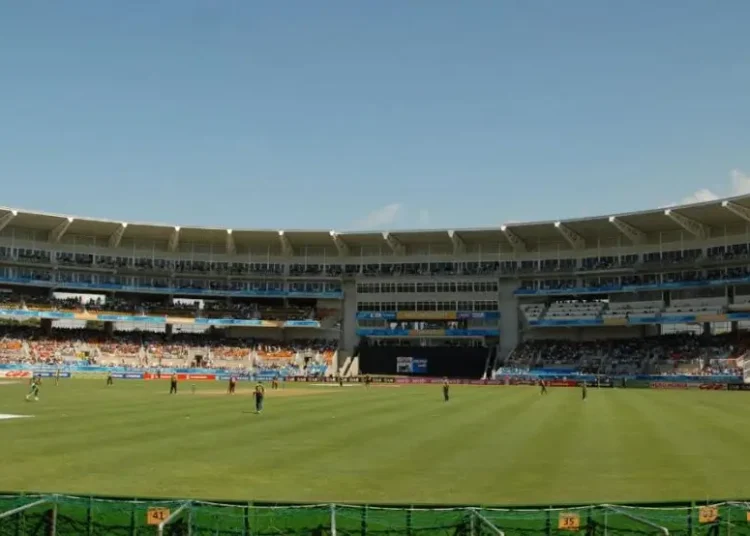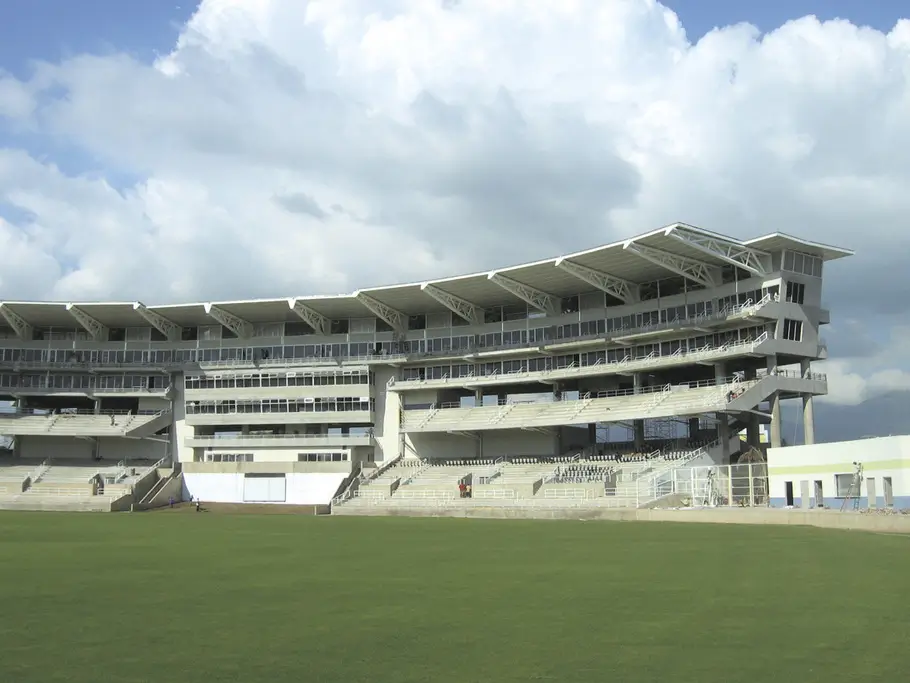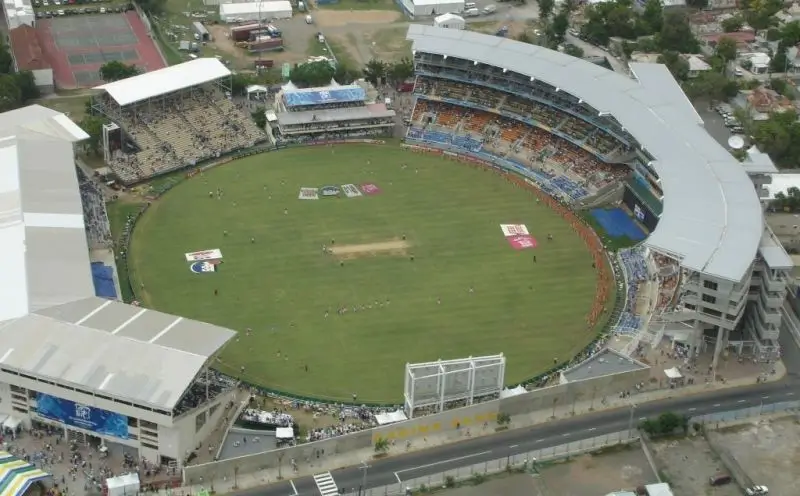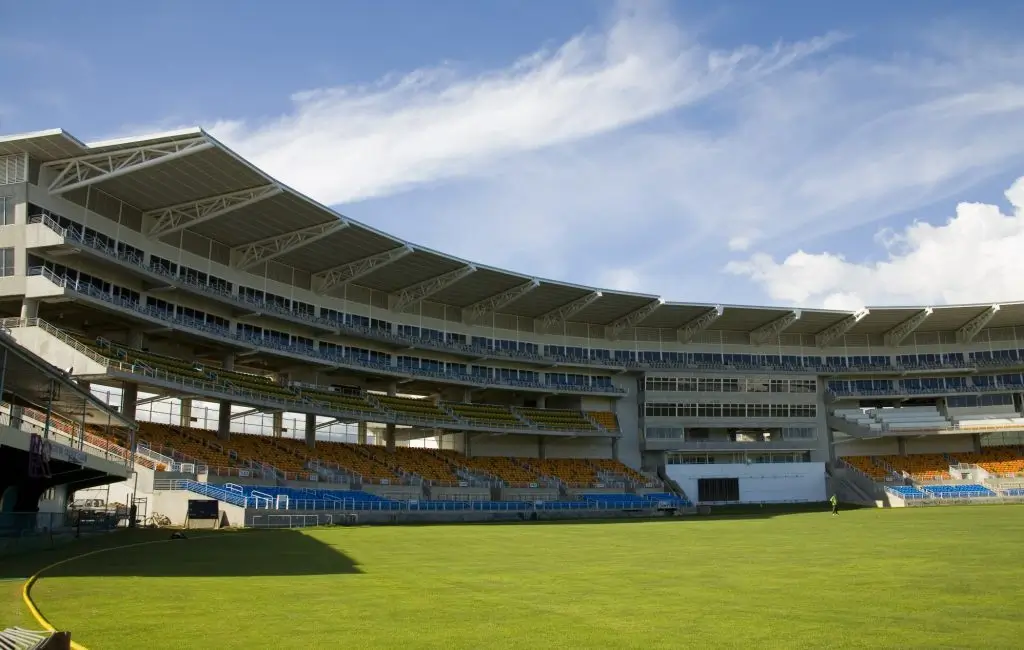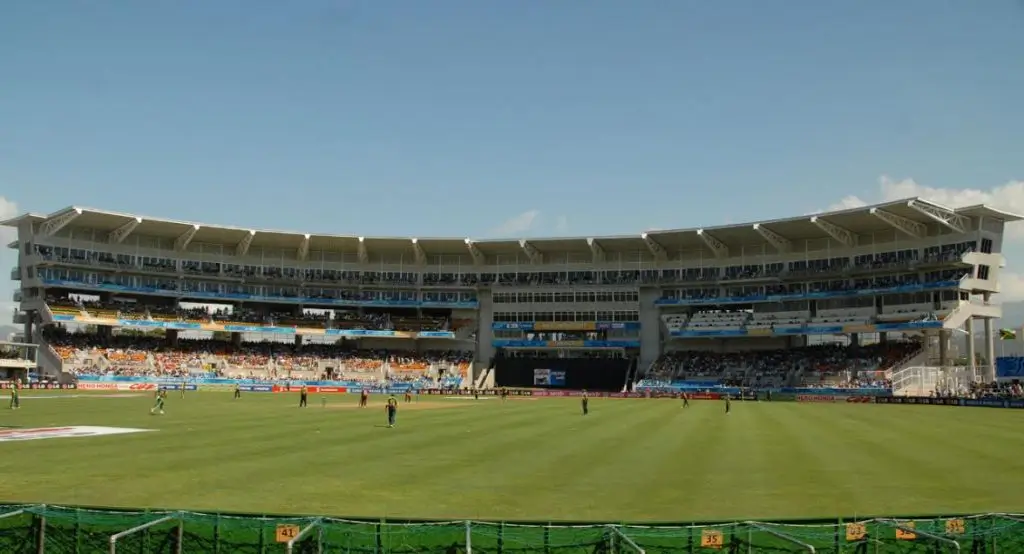Sabina Park is a historic cricket stadium in Kingston, Jamaica, and serves as the home ground for the Kingston Cricket Club. Established in 1930, it has a rich history and is notable for hosting numerous significant cricket matches, including Test matches and One Day Internationals.
Sabina Park is a famous cricket stadium in Kingston, Jamaica. It has a rich history and has seen many exciting matches. This stadium is special because it has hosted games under bright lights and has a beautiful view of the Blue Mountains. It’s a place where fans enjoy cricket and celebrate Jamaican culture.
Sabina Park is not just a place to watch cricket; it’s part of Jamaica’s sports history. It has a lively atmosphere with music and food represents the local culture. The stadium has areas like The Mound where fans can party and enjoy the game. Sabina Park has seen many historical moments, like Garry Sobers’ famous 365 not-out score in 1958. We at CricketStadium will explore the best features of Sabina Park Stadium today.
Sabina Park Stadium Features
- Capacity: After renovations for the 2007 ICC Cricket World Cup, the capacity of Sabina Park was increased to approximately 20,000 spectators, although earlier reports indicated it could accommodate around 30,000.
- Pitch Characteristics: Traditionally known for its fast and bouncy pitch, it has been described as challenging for batsmen but favorable for fast bowlers. However, recent assessments suggest that the pitch has slowed down over time.
- Stands:
- The Mound (Party Stand): Known for its festive atmosphere, spectators often bring food and drinks, creating a lively party environment.
- North Stand: Offers some of the best views of the match.
- Members Pavilion: Reserved for members of the Kingston Cricket Club, maintaining traditional practices.
- George Headley Stand: Named after a legendary Jamaican cricketer, providing scenic views of the Blue Mountains.
Recent Developments
The stadium underwent extensive renovations before the 2007 ICC Cricket World Cup, including modernizing facilities and improving spectator comfort. Floodlights were also installed in 2014, making it suitable for day-night matches.
Sabina Park is not just a sports venue; it embodies Jamaican culture with its vibrant atmosphere during matches. The backdrop of the Blue Mountains enhances the experience, making it a unique location for cricket fans. Sabina Park is a significant landmark in Jamaica’s sporting history, blending rich tradition with modern amenities to host thrilling cricket matches.
What are the best times to visit Sabina Park for a Match?
The best times to visit Sabina Park for a match depend on the type of cricket being played and the overall atmosphere you wish to experience:
Types of Matches
- Test Matches:
- Typically held over five days, these matches provide a traditional cricket experience. Visiting during the first two days is often recommended to witness the initial strategies and performances.
- One Day Internationals (ODIs):
- Generally held in a single day, these matches are exciting and fast-paced. Arriving early lets you soak in the pre-match atmosphere and enjoy local food and festivities.
- T20 Matches:
- These shorter matches are known for their vibrant atmosphere, often featuring music and entertainment. Attending a T20 match in the evening can be particularly enjoyable due to the lively crowd and cooler temperatures.
Seasonal Considerations
Peak Season: The Caribbean Premier League (CPL), usually held in August, is a prime time for T20 matches at Sabina Park, attracting large crowds and creating a festival-like atmosphere.
Weather: Kingston is generally dry, but checking for rain forecasts is advisable, especially during the Caribbean rainy season (May to November).
General Recommendations
Arrive Early: For all matches, arriving at least an hour before the start time is advisable to explore the stadium, grab food from vendors, and find your seat.
Evening Matches: If possible, opt for evening matches, especially T20s, as they tend to have a more festive environment with floodlights enhancing the experience.
Plan your visit around the type of match you want to see and consider seasonal factors for an optimal experience at Sabina Park.
How early should I arrive to secure a good spot at Sabina Park?
To secure a good spot at Sabina Park for a match, arriving at least 1 to 2 hours before the scheduled start time is advisable. This early arrival allows you to:Choose Your Seats: Since tickets are often sold for sections rather than specific seats, arriving early gives you the best chance to select a desirable location.
Enjoy the Atmosphere: You can soak in the pre-match excitement, grab food from local vendors, and engage with fellow fans.
Avoid Last-Minute Rush: Arriving early helps avoid potential traffic delays and ensures ample time to find your way around the stadium.
Additional Tips
Check Match Timing: Verify the match’s start time, as it can vary between formats (Test, ODI, T20).
Consider Weekend Matches: For popular matches, especially during events like the Caribbean Premier League (CPL), arriving even earlier may be beneficial due to larger crowds.
Planning your arrival accordingly can enhance your overall experience at Sabina Park.
What are the most common foods and drinks sold at Sabina Park?
At Sabina Park, various local foods and drinks enhance the match-day experience. Here are some of the most common options:
Popular Foods
- Fried Chicken: A staple at many Jamaican events, often served crispy and flavorful.
- Fried Breadfruit: A traditional Caribbean dish that complements the fried chicken well.
- Chips (Fries): Commonly served as a side, providing a familiar snack option.
- Jerk Chicken: Known for its spicy and smoky flavor, it is a must-try for visitors.
- Patties: These flaky pastries filled with meat or vegetables are popular snacks among fans.
- Local Soups: Often chicken-based, these hearty soups are available at some vendors.
Common Drinks
- Red Stripe Beer: This iconic Jamaican lager is widely consumed at matches, contributing to the festive atmosphere.
- Rum Punch: A fruity cocktail popular among fans looking for a refreshing drink.
- Sodas and Soft Drinks: Standard options like cola and ginger ale are also available.
The food vendors at Sabina Park contribute to a lively and vibrant environment, making it an integral part of the cricket-watching experience. Arriving early allows you to sample these local delicacies while enjoying the pre-match excitement.
How does the weather typically affect matches at Sabina Park?
Weather conditions significantly influence matches at Sabina Park, impacting gameplay and spectator experience. Here are the key ways weather affects cricket at this venue:
Temperature and Humidity
Warm Conditions: Average temperatures at Sabina Park typically hover around 28-33°C during match days. Warm weather can lead to a dry pitch, favoring batsmen as the ball tends to come onto the bat more easily, resulting in higher scores.
Humidity Levels: High humidity can affect player performance, making conditions muggy. It can also influence how the ball behaves, particularly for fast bowlers who may benefit from the moisture in the air, allowing for better swing.
Rain and Thunderstorms
Rain Interruptions: The Caribbean is known for its unpredictable weather, with rain being a common occurrence. Matches can be interrupted or delayed due to rain, especially during the rainy season (May to November). For instance, forecasts have indicated a 44% chance of rain, which could lead to significant disruptions during matches.
Pitch Moisture: Rain increases moisture levels in the pitch, which can assist bowlers, particularly fast bowlers who thrive on a damp surface. This can lead to lower scores if conditions are conducive to swing bowling.
Overcast Conditions
Bowler’s Advantage: Overcast skies often favour bowlers, especially seamers, as the ball tends to swing more in humid and cloudy conditions. This can lead to challenging batting conditions and lower scoring rates.
Day-Night Matches
Dew Factor: In day-night matches, dew can become a factor in the second innings, making it difficult for bowlers to grip the ball effectively. This often leads to higher scores in the game’s latter half due to batting advantages.
Overall, while clear and warm weather benefits batsmen by creating favorable batting conditions, overcast skies, and rain can shift the advantage toward bowlers. Fans attending matches at Sabina Park should monitor weather forecasts to anticipate potential interruptions and prepare for varying conditions.
How does humidity affect the gameplay at Sabina Park?
Humidity plays a significant role in affecting gameplay at Sabina Park, impacting both players and match conditions in various ways:
Impact on Players
- Physical Discomfort: High humidity levels, often around 70-80%, can lead to discomfort for players, causing fatigue more quickly due to increased sweating and dehydration. This can affect their performance, particularly in longer formats like Test matches where stamina is crucial.
- Grip and Control: Humid conditions can make it challenging for bowlers to maintain grip on the ball, especially spinners who rely on precise finger placement. This may lead to less effective deliveries and higher run-scoring opportunities for batsmen.
Influence on Gameplay
- Ball Behavior: Humidity can enhance swing bowling conditions. Fast bowlers may benefit from the moisture in the air, which can cause the ball to swing more, especially in the early overs. This can lead to early breakthroughs for the bowling side if they exploit these conditions effectively.
- Pitch Conditions: While Sabina Park has evolved into a batting-friendly pitch, high humidity can dampen the surface, potentially aiding seam movement and bounce early in a match. The pitch favors batting more as the match progresses and conditions dry out.
- Rain Interruptions: High humidity often correlates with rain threats, which can lead to interruptions in play. Matches may be affected by showers or thunderstorms, resulting in delays or reduced overs.
Humidity at Sabina Park can significantly influence player performance and match dynamics, favoring bowlers in initial phases while posing challenges related to player comfort and game continuity.
How does the weather impact the pitch conditions at Sabina Park?
Weather conditions significantly impact the pitch conditions at Sabina Park, influencing how the game unfolds. Here are the key factors:
Moisture Levels
- Rain Effects: When it rains, the pitch becomes wet, which can alter its behaviour. A damp pitch may lead to less bounce and more movement, making it challenging for batsmen to score runs effectively. Fast bowlers often thrive under these conditions, as the ball can swing and seam more, creating difficulties for batters.
- Drying Process: After the rain stops, the pitch begins to dry but may remain uneven. This can lead to unpredictable bounce and behavior, affecting both batting and bowling strategies.
Humidity
Increased Humidity: High humidity levels can dampen the pitch, aiding fast bowlers early in the innings. This moisture can enhance swing and seam movement, making it advantageous for bowlers during the initial overs. As the match progresses and humidity decreases, conditions may become more favourable for batting.
Temperature
Heat Impact: Hot temperatures can dry out the pitch quickly. A dry pitch typically favours batsmen as it becomes easier to bat on over time. However, if temperatures are high without sufficient moisture, cracks may develop, leading to variable bounce later in the game.
Overcast Conditions
Bowler-Friendly Atmosphere: Overcast skies often favour bowlers due to increased humidity and moisture in the air, enhancing swing. This can lead to a more bowler-friendly pitch early in a match, especially if rain has recently fallen.
Sabina Park’s weather is crucial in determining pitch conditions. Rain and humidity generally favor bowlers by enhancing movement and seam early on, while dry and hot conditions benefit batsmen as the game progresses. Understanding these dynamics is essential for teams to strategize effectively during matches at this venue.
Do spin bowlers face any specific weather-related challenges at Sabina Park?
Spin bowlers at Sabina Park face several weather-related challenges that can affect their performance and effectiveness during matches:
Humidity
Grip Issues: High humidity levels, often around 80%, can make it difficult for spin bowlers to grip the ball properly. This can lead to less control over spin and trajectory, reducing their effectiveness in turning the ball sharply.
Ball Deterioration: Humid conditions can also cause the ball to become damp, which may hinder its ability to grip the surface effectively when bowled, leading to reduced spin.
Pitch Conditions
Dryness and Cracks: While dry conditions can sometimes benefit spin bowlers by allowing them to extract turn and bounce, Sabina Park’s pitch has been noted for not developing significant cracks that spinners can exploit. This means that spinners might not find as much assistance as expected, even in dry weather, especially later in the match when the pitch remains consistent.
Moisture from Rain: Rain can lead to a damp pitch, favoring seam and swing bowlers more than spinners. A wet pitch typically provides less grip for spin bowlers, making it challenging to utilize their skills effectively.
Overcast Conditions
Swing and Seam Movement: Overcast weather often enhances conditions for fast bowlers due to increased moisture in the air, which aids swing and seam movement. This can make it difficult for batsmen to settle in against pace bowling, reducing opportunities for spinners to come into play effectively.
Temperature Effects
Extreme Heat: High temperatures can lead to a dry pitch that initially appears favourable for spin bowling. However, if the pitch becomes too hard and baked under extreme heat, it may not offer the necessary grip for spinners later in the game.
While certain weather conditions at Sabina Park can provide opportunities for spin bowlers, challenges such as high humidity, rain-induced dampness, and overcast skies can significantly hinder their performance. Spin bowlers must adapt their strategies based on these conditions to maximize their effectiveness during matches.
Sabina Park Stadium Batting or Bowling Pitch
Sabina Park in Kingston, Jamaica, is primarily recognized as a bowler-friendly pitch. Historically, it has favored fast bowlers who can exploit the bounce and movement available, especially in the game’s early stages. The conditions assist pacers significantly, making them crucial for taking wickets early on. Spinners may also find some assistance as matches progress, but the initial advantage lies with fast bowlers.
Pitch Characteristics
- Bowling Conditions: The pitch is known for supporting pace bowlers due to early movement and bounce. This means that teams winning the toss often prefer to bowl first to take advantage of these conditions.
- Batting Conditions: While the pitch is bowler-friendly, it can become more conducive to batting as the game progresses. Batters may find it easier to score runs later in the match when the pitch flattens out.
Match Statistics
- In T20 matches at Sabina Park, teams batting first have won 5 out of 9 games, while teams bowling first have won 4. The average first innings score is around 165 runs1.
- In ODIs, out of 47 matches, teams batting first have won 20 times compared to 25 wins for teams bowling first.
Sabina Park is characterized by its favorable conditions for bowlers, particularly fast bowlers, during the initial overs of a match. Strategic decisions regarding batting and bowling are crucial for teams competing at this venue.
What makes Sabina Park a bowler-friendly pitch?
Sabina Park is recognized as a bowler-friendly pitch for several reasons that enhance the effectiveness of bowlers, particularly fast bowlers:
1. Early Movement and Bounce
The pitch at Sabina Park typically offers good pace and bounce, particularly during the early stages of a match. Fast bowlers can extract movement off the seam, making it challenging for batsmen to settle in. This early assistance is crucial for taking wickets, especially in the first few hours of play.
2. Pitch Composition
The pitch is characterized by a hard surface with grass cover, contributing to its bounce and pace. The curator has emphasized maintaining the grass on the pitch to ensure it remains lively, allowing fast bowlers to benefit from both bounce and seam movement.
3. Weather Conditions
Humidity and overcast conditions can further enhance bowling prospects. High humidity can assist in swing bowling, while overcast skies often favor pacers due to increased moisture in the air. These conditions make it more difficult for batsmen to score runs freely.
4. Limited Assistance for Spinners
While spinners may come into play as the game progresses, they generally receive less assistance from the pitch than fast bowlers. The pitch does not break down significantly, meaning spinners may struggle to find a turn or grip as effectively as they would on other surfaces.
5. Historical Context
Historically, Sabina Park has been known for its lively pitches that provide a nightmare for batsmen and an open feast for fast bowlers. Although the pitch has changed over the years, it still retains characteristics that favor bowlers, particularly in Test matches.
Sabina Park’s blend of early movement, consistent bounce, and favorable weather conditions makes it a challenging venue for batsmen while providing ample opportunities for bowlers to excel. Teams often prefer to bowl first upon winning the toss to take advantage of these conditions early in the match.
What is the Boundary Length at Sabina Park?
The boundary lengths at Sabina Park are as follows:
- Straight Boundary: 76 meters
- Off Side Boundary: 69 meters
- Leg Side Boundary: 61 meters
- Back Side Boundary: 59 meters
These dimensions indicate that the boundaries vary depending on the direction, with straight boundaries being the longest and leg side boundaries being the shortest. This variation can influence match strategies, particularly in batting and bowling tactics. The overall field size is approximately 135 meters by 130 meters.
How do the boundary lengths at Sabina Park influence the team’s decision to bat or bowl first?
The boundary lengths at Sabina Park can significantly influence a team’s decision to bat or bowl first, particularly in terms of strategy and gameplay dynamics. Here’s how:
1. Boundary Lengths and Scoring Opportunities
Shorter Boundaries: With leg-side boundaries measuring around 61 meters and back-side boundaries at 59 meters, teams may prefer to bat first if they can exploit these shorter distances to score quickly. Batsmen can target these areas for boundaries, leading to higher scores early in the innings.
Longer Straight Boundary: The straight boundary at 76 meters poses a challenge for batsmen, especially against fast bowlers who can generate bounce and movement. This might encourage teams with strong bowling attacks to consider bowling first, capitalizing on the difficulty batsmen may face in clearing the longer straight boundary.
2. Pitch Conditions and Weather Influence
Early Movement: Bowlers may find early assistance from the pitch if conditions are overcast or humid. In such cases, teams winning the toss might opt to bowl first to take advantage of the favorable conditions before the pitch settles down, especially given the shorter boundaries that could lead to higher scoring if batting later.
Impact of Moisture: Rain or high humidity can make the pitch conducive for seam movement, which may sway captains to bowl first. If they believe they can restrict the opposition to a low score due to challenging batting conditions, they might feel more confident in chasing down a target on a pitch that could become easier for batting as it dries.
3. Historical Performance and Strategy
Previous Match Outcomes: Teams often analyze past performances at Sabina Park. If historical data suggests that teams batting first have been successful due to favorable boundary lengths and pitch conditions, captains may choose to bat first when winning the toss.
Bowling Attack Strength: A team with a strong bowling lineup might opt to bowl first if they believe they can exploit the pitch conditions effectively against a batting lineup that may struggle with shorter boundaries early on.
The boundary lengths at Sabina Park play a crucial role in influencing tactical decisions regarding whether to bat or bowl first. Captains must consider not only the dimensions of the field but also prevailing weather conditions and historical performance trends when choosing at the toss.
What are some unique features of Sabina Park Stadium?
Sabina Park features several unique design elements that contribute to its character and functionality as a premier cricket venue:
1. Architectural Blend
The stadium showcases a harmonious blend of traditional and modern architectural elements. Its grandstands are constructed primarily of reinforced concrete, featuring arched entrances and ornate columns that reflect the colonial heritage of Jamaica while incorporating modern amenities.
2. Grandstand Design
The Grandstand is particularly noteworthy, designed with a curved roof that provides expansive seating and spectator comfort. This design ensures unobstructed views of the playing field, enhancing the spectator experience.
3. Natural Ventilation
The stadium incorporates natural ventilation through strategically placed openings, allowing for a cooler environment even in the Caribbean’s warm and humid climate. This feature enhances comfort for both players and fans.
4. Modern Facilities
Sabina Park has been upgraded with state-of-the-art facilities, including hospitality suites, media centers, and locker rooms, catering to the needs of players and spectators alike. These modern amenities ensure that the stadium meets international standards for cricketing events.
5. Floodlights for Night Matches
In 2014, Sabina Park installed floodlights, becoming the last international ground in the Caribbean. This upgrade allows for day/night matches, enhancing the viewing experience and enabling the stadium to host a wider range of events.
6. Unique Location and Atmosphere
The stadium’s location in Kingston contributes to its vibrant atmosphere. Surrounded by ten-foot walls that create an intimate setting, the noise from passionate crowds adds to the intensity of matches, making it feel like a coliseum.
7. Historical Significance
Established in 1895, Sabina Park is steeped in history, hosting numerous memorable matches and record-breaking performances. Its legacy adds a layer of significance to its design, making it more than just a sports venue.
These unique features make Sabina Park a functional cricket ground and a historic and culturally significant site in Jamaica’s sporting landscape.
Stadium Capacity at Sabina Park
The current seating capacity of Sabina Park is 20,000 spectators. This capacity was increased from its previous limit of 15,000 during renovations in preparation for the 2007 Cricket World Cup. The stadium is located in Kingston, Jamaica, and is a significant venue for domestic and international cricket matches.
How do the modern amenities at Sabina Park enhance the spectator experience?
Modern amenities at Sabina Park significantly enhance the spectator experience in several ways. The stadium features well-designed grandstands, including the North Stand, which offers elevated seating for optimal viewing angles. This design ensures that spectators have unobstructed field views, enhancing their enjoyment of the match.
1. Hospitality Suites
State-of-the-art hospitality suites provide a premium experience for fans, allowing them to enjoy matches comfortably while accessing exclusive services. These suites cater to corporate guests and special events, adding a layer of luxury to the cricketing experience.
2. Modern Concessions and Facilities
Upgraded restroom facilities and concession stands offer a wide range of food and drink options, ensuring spectators can enjoy local cuisine and refreshments without missing much of the action. The presence of food vendors enhances the overall match-day atmosphere.
3. Advanced Scoreboards
The recent installation of a state-of-the-art HD scoreboard enhances the visual experience for spectators by providing real-time updates, statistics, and replays. This feature lets fans stay engaged with the game and closely follow key moments.
4. Enhanced Accessibility
Renovations have included improvements in accessibility, such as elevators and better pathways, making it easier for all fans, including those with disabilities, to navigate the stadium comfortably.
5. Crowd Management Systems
Efficient crowd management systems have been implemented to ensure smooth entry and exit from the stadium, minimizing congestion and enhancing safety during matches.
6. Unique Atmosphere
The design incorporates areas like “The Mound,” known for its vibrant party atmosphere where fans gather to celebrate matches with music and camaraderie. This contributes to an electrifying environment that is unique to Sabina Park.
These modern amenities at Sabina Park create a more enjoyable and comfortable experience for spectators, allowing them to fully immerse themselves in the excitement of live cricket while enjoying enhanced facilities and services.
Famous Matches at Sabina Park
Several famous matches at Sabina Park have highlighted how boundary lengths can influence gameplay and outcomes. Here are a few notable instances:
1. Garry Sobers’ 365 Not Out (1958)
In this historic Test match against Pakistan, Garry Sobers set the record for the highest individual score in Test cricket. The relatively short boundaries allowed Sobers to capitalize on his powerful hitting, making it easier to clear the ropes. His innings showcased how boundary dimensions can impact scoring, especially for aggressive batsmen.
2. England vs. West Indies (1998)
This match is infamous for being abandoned due to an unplayable pitch, but it also highlighted how boundary lengths can affect match conditions. The shorter leg side boundary (61 meters) and the longer straight boundary (76 meters) meant that bowlers had to be precise with their line and length. The abandonment underscored the importance of pitch preparation and boundary dimensions in ensuring fair play.
3. West Indies vs. Australia (2006)
During this Test match, bowlers from both teams had to adapt to the varying boundary lengths while strategizing their bowling plans. The fast bowlers utilized the longer straight boundaries to focus on line and length, while spinners attempted to exploit the shorter boundaries by targeting batsmen’s weaknesses. The match illustrated how teams could leverage boundary dimensions in their tactical approaches.
4. West Indies vs. Bangladesh (2024)
In a recent Test, the shorter boundaries were a factor as players attempted aggressive strokes to maximize scoring opportunities. The match demonstrated how teams could adjust their batting strategies based on boundary lengths, with batsmen targeting specific field areas to take advantage of the shorter distances.
These matches at Sabina Park reflect how boundary lengths can play a crucial role in shaping team strategies, influencing batting approaches, and affecting overall match outcomes. Teams often consider these dimensions when deciding whether to bat or bowl first, as they can significantly impact scoring potential and bowling tactics throughout the game.

